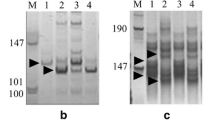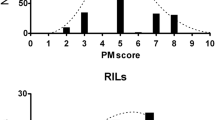Abstract
The race of watermelon powdery mildew (PM) present in South Korea was confirmed, and genetic inheritance of resistance to this race was determined from a cultivars ‘Arka Manik’. Bioassay tested on a set of melon differential genotypes indicated that the race of P. xathii predominating in South Korea was either belonged to race 1W or another race different from race 2W. Inheritance of PM resistance was studied from F2, F2:3, and reciprocal backcross generations derived from ‘Arka Manik’ (resistant cultivar) × HS3355 (susceptible line). The segregation ratios indicated that resistance to PM in ‘Arka Manik’ is conditioned by a single incompletely dominant gene (Pm1.1). Bulked segregant analysis (BSA) of F2 plants using random amplification of polymorphic DNA (RAPD) identified one polymorphic polymerase chain reaction (PCR) band (OP-R483) and a close linkage (3.6 cM) was observed between resistance and OP-483. The marker OP-483 was converted to cleaved amplified polymorphic sequence (CAPS-G/C) and a single nucleotide polymorphism (SNP) marker (MCA-A/G) using melting curve analysis. MCA-A/G marker genotyping of a wide range of susceptible breeding lines revealed that the marker allele of ‘Arka Manik’ was unique in breeding populations.
Similar content being viewed by others
Literature cited
Brown, A.H.D., G.J. Lawrence, M. Jenkin, J. Douglass, and E. Gregory. 1989. Linkage drag in backcross breeding in barley. J. Hered. 80:234–239.
Chantret, N., P. Sourdille, M. Roder, M. Tavaud, M. Bernard, and D. Doussinault. 2000. Location and mapping of the powdery mildew resistance gene MIRE and detection of a resistance QTL by bulked segregant analysis (BSA) with microsatellite in wheat. Theo. Appl. Genet. 100:1217–1224.
Collard, B.C.Y. and D.J. Mackill. 2008. Marker-assisted selection: An approach for precision plant breeding in the twenty-first century. Phil. Trans. R. Soc. B. 363:557–572.
Davis, A.R., C.E. Thomas, A. Levi, B.D. Bruton, S.D. Pair, and C.E. Thomas. 2001. Powdery mildew: An emerging disease of watermelon in the United States. Cucurbit Genet. Coop. Rpt. 24:42–48.
Davis, A.R., C.E. Thomas, A. Levi, B.D. Bruton, and S.D. Pair. 2002. Watermelon resistance to powdery mildew race 1, p. 192–198. In: D.N. Maynard (ed.). Cucurbitaceae ′02. ASHS Press, Alexandria, VA.
Davis, A.R., A. Levi, T. Wehner, and M. Pitrat. 2006a. PI 525088-PMR, a melon race 1 powdery mildew resistant watermelon line. HortScience 41:1527–1528.
Davis, A.R., A. Tetteh, T. Wehner, A. Levi, and M. Pitrat. 2006b. Watermelon resistance to powdery mildew race 1 and race 2. p. 412–420. In: G.J. Holmes (ed.). Proc. Cucurbtaceae 2006. Universal Press, Raleigh, NC.
Davis, A.R., A. Levi, A. Tetteh, T. Wehner, V. Russo, and M. Pitrat. 2007. Evaluation of watermelon and related species for resistance to race 1W powdery mildew. J. Amer. Soc. Hort. Sci. 132:790–795.
Giovanni, C.D., P. Dell’Orco, A. Bruno, F. Ciccarese, C. Lotti, and L. Ricciardi. 2004. Identification of PCR-based marker (RAPD, AFLP) linked to a novel powdery mildew resistance gene (ol-2) in tomato. Plant Sci. 166:41–48.
Hwang, J., S. Ahn, J. Oh, Y. Choi, J. Kang, and Y. Park. 2011. Functional characterization of watermelon (Citrullus lanatus L.) EST-SSR by Gel electrophoresis and high resolution melting analysis. Scientia Hort. 130:715–724.
Huang, X. and M. Roder. 2004. Molecular mapping of powdery mildew resistance genes in wheat: A review. Euphytica 137: 203–223.
Je, H.J., Y.O. Park, S.C. Kim, J.H. Hwang, Y.J. Lee, B.G. Son, and Y.H. Park. 2009. Evaluation of genetic relationships among persimmon cultivars introduced and indigenous in Korea using RAPD. Kor. J. Hort. Sci. Technol. 27:448–455.
Keinath, A.P. and V.B. Dubose. 2004. Evaluation of fungicides for prevention and management of powdery mildew on watermelon. Crop Protection 23:35–42.
Kim, J.K., D.C Ahn, H.J. Oh, K.H. Kim, Y.M. Choi, S.Y. Oh, N.J. Kamg, B.R. Jeong, Z.H. Kim, and Y.H. Park. 2010. Skewed inheritance of EST-SSR alleles in reciprocal crosses of cut roses. Kor. J. Hort. Sci. Technol. 28:618–626.
Lee, W.M., S.H. Son, D.K. Park, H.J. Lee, Y.C. Huh, and I.H. Cho. 2010. Selection of watermelon germplasm with disease resistance to powdery mildew (Sphaerotheca fusca). Kor. J. Hort. Sci. Technol. 28 (Suppl. II):73. (Abstr.)
McGrath, M.T. and C.E. Thomas. 1996. Powdery mildew, p. 28–30. In: T.A. Zitter, D.L. Hopkins, and C.E. Thomas (eds.). Compendium of cucurbit disease. The Amer. Phytopathol. Soc. St. Paul, MN.
Michelmore, R.W., I. Paran, and R.V. Kesseli. 1991. Identification of markers linked to disease resistance genes by bulked segregant analysis: A rapid method to detect markers in specific genomic regions by using segregating populations. Proc. Natl. Acad. Sci. USA 88:9828–9832.
Moose, S.P. and R.H. Mumm. 2008. Molecular plant breeding as the foundation for 21 st century crop improvement. Plant Physiol. 147:969–977.
Rai, M., S. Pandey, and S. Kumar. 2008. Cucurbit research in India: A retrospect. Cucurbitaceae proceedings of the IX th EUCARPIA meeting on genetics and breeding of Cucurbitaceae (Pitrat M, ed), INRA, Avignon(France), May 21–24, 2008.
Tester, M. and P. Langridge. 2010. Breeding technologies to increase crop production in a changing world. Science 327:818–822.
Tetteh, A.Y., T.C. Wehner, and A.R. Davis. 2010. Identifying resistance to powdery mildew race 2W in the USDA-ARS watermelon germplasm collection. Crop Sci. 50:933–939.
Zamir, D. 2001. Improving plant breeding with exotic genetic libraries. Nature 2:983–989.
Author information
Authors and Affiliations
Corresponding author
Additional information
Electronic supplementary material: The online version of this article (doi:10.1007/s13580-013-0156-1) contains supplementary material, which is available to authorized users.
Electronic supplementary material
Rights and permissions
About this article
Cite this article
Kim, KH., Ahn, SG., Hwang, JH. et al. Inheritance of resistance to powdery mildew in the watermelon and development of a molecular marker for selecting resistant plants. Hortic. Environ. Biotechnol. 54, 134–140 (2013). https://doi.org/10.1007/s13580-013-0156-1
Received:
Revised:
Accepted:
Published:
Issue Date:
DOI: https://doi.org/10.1007/s13580-013-0156-1




